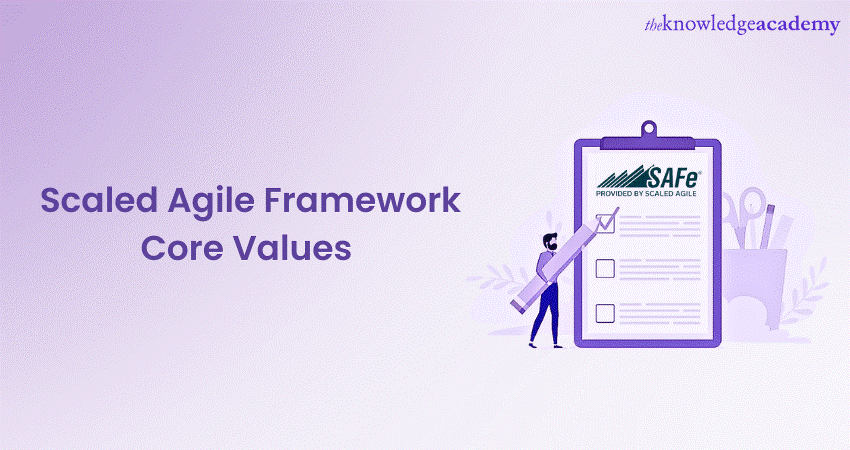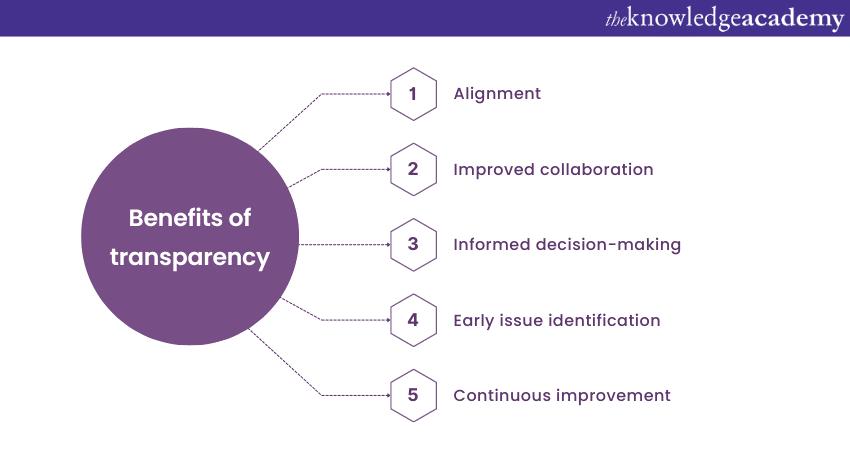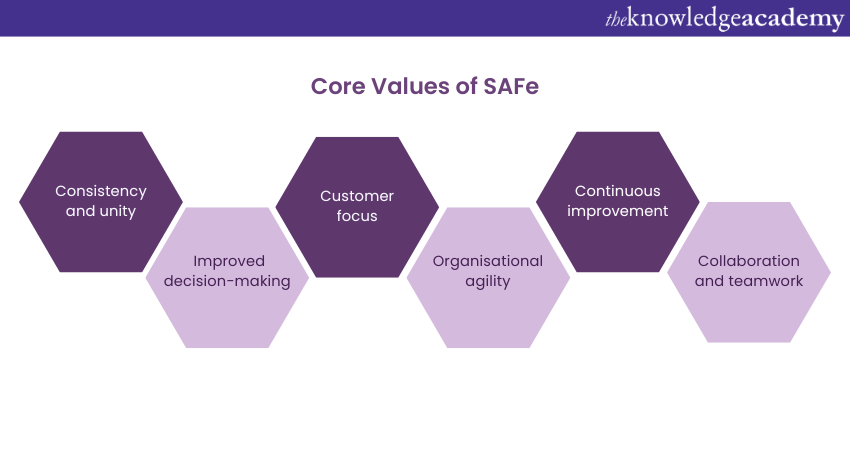We may not have the course you’re looking for. If you enquire or give us a call on +30 2111995372 and speak to our training experts, we may still be able to help with your training requirements.
We ensure quality, budget-alignment, and timely delivery by our expert instructors.

Looking to drive your organisation’s success with a scalable Agile approach? The Scaled Agile Framework Core Values are the foundation that ensures efficiency, quality, and transparency in your Agile journey. By embracing Alignment, Built-in Quality, Transparency, and Program Execution, your teams can achieve better collaboration, faster delivery, and continuous improvement.
Imagine the impact of a well-aligned, transparent, and high-quality process that empowers your organisation to execute Agile at scale. These core values ensure consistency and business agility across all levels of your enterprise. Ready to implement these values and take your Agile practices to the next level? Dive into this blog on Scaled Agile Framework Core Values and start shaping your path to success today!
Table of Contents
1) What is a Scaled Agile Framework (SAFe)?
2) Understanding the Scaled Agile Framework Core Values
3) Why is Following the Core Values of SAFe Important?
4) Major Obstacles to Agile Scaling in Organisations
5) The Continuous Integration Activities
6) How do SAFe Core Values Stabilise and Accelerate how Agile Teams Advance?
7) Conclusion
What is Scaled Agile Framework (SAFe)?
Scaled Agile Framework (SAFe) is a comprehensive methodology that provides organisations with a structured approach to scaling Agile practices across teams, programs, and the entire enterprise. It combines the principles of Lean, Agile, and DevOps to enable organisations to achieve business agility and deliver value to customers faster and more effectively.
At its core, it promotes a hierarchical structure that aligns and coordinates the work of various teams and ensures a common understanding of goals and objectives. This hierarchical structure consists of four primary levels of SAFE:
a) The team level: Individual Agile teams follow established Agile practices, including Scrum or Kanban, to deliver value incrementally.
b) The program level: Focuses on coordinating multiple Agile teams that work together to deliver a larger solution.
c) The portfolio level: Ensures that the work carried out at the program and team levels aligns with the overall business goals and objectives.
d) The value stream level: It Focuses on aligning the delivery of value across multiple ARTs and teams.
Further, the methodology recognises that traditional Agile practices, which work well for small teams, may not be sufficient for large-scale. To address this challenge, SAFe provides a set of principles, practices, and competencies that organisations can leverage to scale their agile efforts.

Understanding the Scaled Agile Framework Core Values
The success of the Scaled Agile Framework (SAFe) lies in its Core Values, which serve as guiding principles to foster collaboration, alignment, built-in quality, transparency, and execution. Let’s explore these Core Values in detail to gain an in-depth understanding of their significance in achieving agility at scale:
a) Alignment
Alignment is a critical aspect of SAFe that ensures every employee in the company is working towards a common vision and set of objectives. It establishes a cohesive and synchronised approach, enabling teams, programs, and portfolios to work together effectively. Let’s delve deeper into the benefits of Alignment in SAFe:
a) Clear vision and direction for effective decision-making and promoting goal-oriented work.
b) Efficient resource allocation to prevent duplication of efforts, minimising wastage, and optimising resource utilisation.
c) Reduced conflicts and dependencies by addressing issues swiftly, minimising disruptions and delays.
d) Improved decision-making, ensuring that resources are allocated to the most critical and value-adding initiatives.
e) Agility and adaptability to help organisations adapt their strategies and execution plans, maintaining a competitive edge.
b) Built-in Quality
In SAFe, Built-in quality emphasises the importance of consistently delivering high-quality products and services throughout the development process. By prioritising quality from the outset, organisations can minimise defects, reduce rework, and ensure customer satisfaction. Here are a few benefits that this Core Value provides:
a) Enhanced customer satisfaction by consistently delivering high-quality solutions
b) Reduced rework and technical debt by timely detecting and resolving defects
c) Improved time-to-market by minimising defects and delivering solutions more rapidly
d) Increased productivity and efficiency by automating testing and streamlining processes
e) Promotes a culture of excellence by emphasising Built-in quality and instilling a sense of pride in delivering high-quality solutions
c) Transparency
Another Core Value that SAFe promotes is Transparency. It is a combination of values like openness, visibility, and clear communication within an organisation. By embracing transparency, teams can foster trust, facilitate collaboration, and make informed decisions. Let’s explore the benefits of Transparency in SAFe and how it adds to the success of Agile enterprises:

a) Alignment and shared understanding of priorities, enabling teams to work towards common objectives.
b) Improved collaboration and teamwork by exchanging ideas, sharing knowledge, and leveraging collective intelligence to solve problems and deliver value.
c) Informed decision-making promotes efficiency, reduces risks, and supports the organisation’s overall success.
d) Early identification and resolution of issues, preventing the organisation from escalating and impacting its performance.
e) Continuous improvement and adaptation by sharing information and feedback openly.
d) Program Execution
Program execution is the final value that the Scaled Agile Framework (SAFe) promotes. It focuses on delivering value to customers with speed, efficiency, and excellence. Further, it emphasises the importance of translating strategies into action and achieving measurable outcomes. Let’s dive into the benefits of the Program execution:
a) Faster time-to-market and get a competitive advantage.
b) Improved customer satisfaction by consistently delivering high-quality solutions.
c) Optimised resource utilisation by ensuring the reduction of waste and maximising productivity.
d) Greater agility and adaptability can be achieved by embracing Agile practices and iterative delivery.
e) Alignment and coordination between teams, departments, and stakeholders towards common goals, facilitating collaboration, and minimising miscommunication.
e) Leadership
SAFe highlights the importance of lean-agile leadership because leaders are the ones who can make real changes in the system and create the right environment for embracing core values. Without strong leadership, it can be hard for organisations to fully adopt SAFe.
Leaders help teams work together, stay aligned, and focus on quality and execution. By promoting a lean-agile mindset, they encourage teams to adapt, improve, and succeed. In short, leadership is key to ensuring the successful use of SAFe and driving positive change across the organisation.
Get a deep understanding of Scrum values and their applications with our Scrum Certification - Register today!
Why is Following the Core Values of SAFe Important?
Following the Core Values of SAFe is of utmost importance for organisations seeking to succeed in today’s competitive and rapidly changing business environment. These Core Values provide a strong foundation for implementing SAFe practices effectively. So, let’s explore why it is crucial to follow these Core Values and how they contribute to organisational success:

a) Consistency and Unity
Adhering to SAFe’s core values ensures consistency and unity across the organisation. In simple terms, when teams and individuals align their efforts with the same set of values, it creates a cohesive and unified approach to achieving common goals. This consistency enhances collaboration, minimises conflicts, and promotes a shared sense of purpose and direction.
b) Improved Decision-making
The Core Values of SAFe guide teams to make informed decisions that align with the organisation’s objectives and customer needs. These values provide a framework for evaluating options, prioritising initiatives, and choosing the most effective course of action. As a result, it enhances decision-making quality at all levels and helps avoid ad hoc or contradictory choices.
c) Customer Focus
The Core Values place a strong emphasis on customer satisfaction and value delivery. It helps organisations shift their focus toward understanding customer needs, preferences, and expectations.
This customer-centric approach drives the development of quality products and services that match customer requirements. As a result, it leads to improved customer satisfaction, loyalty, and ultimately, business success.
d) Organisational Agility
Following the SAFe Values, organisations can embrace agility and adaptability. By aligning teams, fostering transparency, and emphasising execution, they can swiftly respond to market changes, customer demands, and competitive landscapes.
This agility lets them seize opportunities, mitigate risks, and stay ahead of the curve, ensuring long-term viability and resilience.
e) Continuous Improvement
SAFe supports a culture of continuous improvement within an organisation. Its Core Values focus on built-in quality, embrace transparency, and emphasise execution. As a result, organisations can promote an environment that encourages learning, experimentation, and innovation. Further, it also promotes a mindset of seeking better ways to deliver value, identifying areas for improvement, and implementing changes that drive ongoing growth and success.
f) Collaboration and Teamwork
SAFe also promotes collaboration and teamwork across departments and teams. It aims to align efforts, facilitate transparency, and emphasise execution. Therefore, it helps create an environment where individuals collaborate, share knowledge, and work together towards shared goals. This collaboration further enhances communication, breaks down contradictions, and harnesses the collective intelligence and expertise of the organisations.
Major Obstacles to Agile Scaling in Organisations
Organisations face key challenges in scaling agile practices. Some of them are:
1) Cultural Shift: Adapting to Agile requires changing entrenched mindsets and traditional hierarchies, is often met with resistance
2) Leadership Support: Without strong backing from leaders, Agile adoption struggles to gain momentum and resources
3) Complex Projects: As projects grow in size, coordinating multiple teams and managing dependencies becomes intricate
4) Communication Barriers: Maintaining open communication becomes harder as teams expand, especially across locations
5) Legacy Systems: Existing systems that don't align with Agile principles can hinder integration
6) Training Gaps: Inadequate education on Agile leads to misunderstandings and hindered adoption
7) Metrics Misalignment: Traditional metrics might not measure Agile's collaborative value effectively
8) Organisational Silos: Agile thrives on cross-functional teams, but silos slow down decision-making
9) Tool-centric Approach: Focusing solely on tools, not Agile principles, results in superficial implementation
10) Change Resistance: Agile's iterative nature clashes with resistance to frequent changes in some organisations
Want to become an agile Project Manager? Register for our Agile Project Management Foundation (AgilePM®) Course today!
The Continuous Integration Activities
Continuous Integration (CI) is a fundamental practice in software development that involves integrating code changes into a shared repository frequently. The following are some Continuous Integration activities:
a) Architectural and Design Quality
The effectiveness of a system's architecture determines its present and future alignment with business needs. Applying principles like coupling/cohesion, abstraction/encapsulation, and flexibility aids in future-proofing. Design Patterns provide a common language to support these principles and ensure clarity. Considering multiple solutions rather than settling for the first choice is advisable.
b) Code Quality
Code quality is achieved through practices including:
1) Unit Testing: Developers create automated test cases to validate smaller code segments, enhancing overall quality.
2) Pair Programming: Collaborative coding with real-time feedback broadens problem-solving perspectives, leading to better-built quality.
3) Coding Standards: Team ownership promotes independent contributions, and consistent coding standards yield reliable results.
c) System Quality
Design and coding ensure system/product quality aligns with expectations and business value, without surprises.
d) Release Quality
Emphasising release based on customer demand ensures smaller, more frequent, defect-free, and risk-free releases.
e) Transparency
SAFe advocates open communication across teams, promoting access to roadmaps, objectives, and initiatives through tools like Jira and Kanban boards.
f) Program Execution
SAFe's focus on working systems and business outcomes ensures efficient delivery of substantial value. Trust and transparency are crucial for success, as difficulties arise in execution. Aligning, quality checking, and transparency are pivotal for continuous value delivery.
How do SAFe Core Values Stabilise and Accelerate how Agile Teams Advance?
SAFe Core Values steer organisational behaviour within a SAFe portfolio. Defining these values is vital for success, ensuring consistency and a strong culture.
Integrating SAFe is essential for Agile Teams, enabling agility in response to tech and economic shifts. It enhances transparency, collaboration, and value delivery, aligning teams from top to bottom.
SAFe's flexibility suits enterprises of all sizes, emphasising regular software releases. Through Agile Release Trains (ART), teams collaborate in fixed cycles (Program Increments), fostering unity and strategic alignment within Agile and Scaled Agile Framework.
Continuous integration, validation, and customer feedback maintain a robust business relationship. This drives improvements in productivity, quality, employee engagement, and time-to-market.
Conclusion
Incorporating the Scaled Agile Framework Cheat Sheet and Core Values is vital for organisational success. Alignment, built-in quality, transparency, and program execution foster collaboration, customer satisfaction, informed decision-making, and agility. By prioritising these values, organisations position themselves for growth and competitiveness in a highly competitive business market.
Accelerate your Agile leadership journey with our Certified Scaled Agile Framework Leading SAFe® 6.0 Training And Exam.
Frequently Asked Questions
What are the Four Levels of Scaled Agile Framework?

The four levels of SAFe include Team, Program, Large Solution, and Portfolio. The Team level focuses on Agile teams; the Program level oversees multiple teams through Agile Release Trains (ARTs); Large Solution coordinates multiple ARTs, and the Portfolio level aligns enterprise strategy with execution.
What are the Uncommitted Objectives of SAFe?

Uncommitted objectives in SAFe are goals that teams plan to achieve but do not promise due to uncertainty or risks. These objectives are not included in commitment-based plans but are still tracked to provide visibility. This approach helps teams manage risks while aiming to deliver additional value.
What are the Other Resources and Offers Provided by The Knowledge Academy?

The Knowledge Academy takes global learning to new heights, offering over 3,000 online courses across 490+ locations in 190+ countries. This expansive reach ensures accessibility and convenience for learners worldwide.
Alongside our diverse Online Course Catalogue, encompassing 19 major categories, we go the extra mile by providing a plethora of free educational Online Resources like News updates, Blogs, videos, webinars, and interview questions. Tailoring learning experiences further, professionals can maximise value with customisable Course Bundles of TKA.
What is The Knowledge Pass, and How Does it Work?

The Knowledge Academy’s Knowledge Pass, a prepaid voucher, adds another layer of flexibility, allowing course bookings over a 12-month period. Join us on a journey where education knows no bounds.
What are the Related Courses and Blogs Provided by The Knowledge Academy?

The Knowledge Academy offers various Agile Training, including the Certified Scaled Agile Framework Leading SAFe® 6.0 Training And Exam, Agile Project Management Foundation & Practitioner (AgilePM®) Training and Certified Professional In Agile Project Management (CPAPM). These courses cater to different skill levels, providing comprehensive insights into Agile Roles and Responsibilities.
Our Project Management Blogs cover a range of topics related to Agile Framework, offering valuable resources, best practices, and industry insights. Whether you are a beginner or looking to advance your Project Management skills, The Knowledge Academy's diverse courses and informative blogs have got you covered.
Upcoming Project Management Resources Batches & Dates
Date
 Certified Scaled Agile Framework Leading SAFe® 6.0 Training and Exam
Certified Scaled Agile Framework Leading SAFe® 6.0 Training and Exam
Mon 24th Feb 2025
Mon 10th Mar 2025
Sat 22nd Mar 2025
Mon 24th Mar 2025
Sat 19th Apr 2025
Tue 22nd Apr 2025
Sat 17th May 2025
Mon 19th May 2025
Mon 16th Jun 2025
Sat 21st Jun 2025
Mon 30th Jun 2025
Mon 14th Jul 2025
Sat 19th Jul 2025
Mon 28th Jul 2025
Mon 11th Aug 2025
Sat 23rd Aug 2025
Mon 25th Aug 2025
Sat 20th Sep 2025
Mon 22nd Sep 2025
Sat 18th Oct 2025
Mon 20th Oct 2025
Mon 17th Nov 2025
Sat 22nd Nov 2025
Mon 15th Dec 2025
Sat 20th Dec 2025






 Top Rated Course
Top Rated Course


 If you wish to make any changes to your course, please
If you wish to make any changes to your course, please


